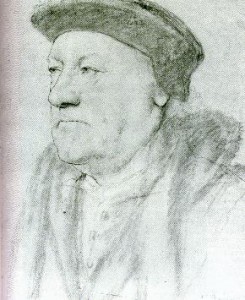
On the 28th July 1540, not only was King Henry VIII marrying his fifth wife, Catherine Howard, but his former trusted adviser and Master Secretary, Thomas Cromwell was being beheaded as a traitor and heretic.
Thomas Cromwell had been denied a trial, instead an Act of Attainder had been used against him. In “The Rise and Fall of Thomas Cromwell: Henry VIII’s Most Faithful Servant”, John Schofield writes about just what Cromwell was accused of:-
- Releasing men convicted or suspected of treason
- Misusing and expropriating funds
- Taking bribes
- Making appointments without royal approval
- Being a “detestable heretic” who had spread heretical literature throughout the kingdom
- Being a “maintainer and supporter of heretics
- Speaking treasonable words – When preachers like Robert Barnes had been reported to him, Cromwell had said: “If the king would turn from it, yet I would not turn; and if the king did turn, and all his people, I would fight in the field in mine own person, with my sword in my hand against him and all other” and “if I live one year or two, it shall not lie in the king’s power to resist or let it if he would”1.
- That he was a sacramentary, a supporter of Zwingli and someone who denied the real presence of Christ in the sacrament.
However, although Cromwell’s real crime was his support of the Anne of Cleves marriage and his failure to annul it, Schofield points out that his ruin “was not the Cleves marriage itself” but that it had “begun with the Lenten crisis, and it was sealed by Henry’s passion for Catherine Howard, stoked up by those feastings and entertainments laid on by wily Winchester at his Episcopal palace.”2 According to Schofield, this meant that Henry VIII “now saw his Lutheran Vicegerent as a threat to the king’s headship of the church, and, even more provocatively, the barrier to Anne’s removal and Catherine’s coronation.”3
Thomas Cromwell’s Execution
Although Cromwell wrote to the king proclaiming his innocence and begging for mercy, he was condemned to death, although it was unclear whether he would have to suffer the full traitor’s death of being hanged, drawn and quartered or be burned at the stake as a heretic. In the end, the King commuted the sentence to beheading, even though Cromwell was not a nobleman by birth.
On the 28th July 1540, Thomas Cromwell climbed the scaffold and addressed the waiting crowd. He opened by saying “I am come hither to die and not to purge myself, as some think peradventure that I will”4 and then he continued by acknowledging that he had offended God and the King and asking forgiveness from both of them. Then he declared “I die in the Catholic faith, not doubting in any article of my faith… nor in any sacrament of the church”5 but Schofield points out that Cromwell was using gallows humour and irony here and was not referring to the medieval Roman Catholic Church, but instead was using the word “Catholic” in the way that Luther, Melancthon and Cranmer did, referring to the “Holy Catholic and Apostolic Church” of the New Testament and Nicene Creed. He continued by denying the charges laid against him and then said:-
“Many have slandered me, and reported that I have been a bearer of such as I have maintained evil opinions; which is untrue: but I confess, that like as God, by His Holy Spirit, doth instruct us in the truth, so the devil is ready to seduce us; and I have been seduced.”6
Although the words “I have been seduced” makes Cromwell sound as if he is confessing his guilt, Schofield explains that it was probably meants as a “sort of sweeping, general confession that all believers make from time to time, like “forgive us our trespasses”, or “all we like sheep have gone astray””.
Cromwell then committed his soul to Christ, calling on his mercy and stating his faith in the resurrection and justification by faith alone:-
“I see and acknowledge that there is in myself no hope of salvation, but all my confidence, hope and trust is in thy most merciful goodness. I have no merits or good works which I may allege before thee.”7
And with this attack on “the work righteousness of medieval religion” and a declaration of his Lutheran beliefs, Thomas Cromwell ended his speech, knelt at the block and was beheaded. The idea that his execution was botched comes from the chronicle of Edward Hall, where he says that Cromwell “so paciently suffered the stroke of the axe, by a ragged and Boocherly miser, whiche very ungoodly perfourmed the office”8, which suggests that it was not a “good” execution, but there is no firm evidence of this and there is no suggestion that the executioner was paid off by Cromwell’s enemies or that they got him drunk. Whatever the real story, it was a sad end to a man who had risen from his humble roots – son of a smith from Putney – to be the Earl of Essex and the King’s chief minister.
RIP Thomas Cromwell, Master Secretary.
Notes and Sources
- The Rise and Fall of Thomas Cromwell: Henry VIII’s Most Faithful Servant, John Schofield, p261
- Ibid., p264
- Ibid.
- Ibid., p268
- Ibid.
- Ibid.
- Ibid., p269
- Hall’s Chronicle, Edward Hall, p839